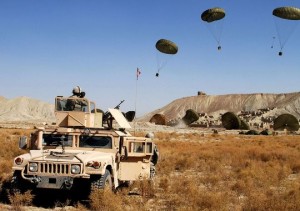
Army celebrates 75 years of the American paratrooper
The Army will honor the 75th anniversary of the American paratrooper with — what else? — a large jump into Fort Benning, Georgia.
The commemoration, led by the Airborne and Ranger Training Brigade, will mark 75 years since the War Department approved the formation of a test platoon of airborne infantry from Fort Benning’s 29th Infantry Regiment. Less than 45 days after it was formed, on Aug. 16, 1940, members of the test platoon made their first jump from a Douglas B-18 over Lawson Army Airfield.
On Aug. 15, today’s paratroopers, along with the Liberty Jump Team, a group of civilian World War II airborne reenactors, will jump into that very same airfield.
“This entire year, we’ve been very cognizant of the 75th anniversary,” said Lt. Col. Korey Brown, commander of 1st Battalion, 507th Parachute Infantry Battalion, and commander of the U.S. Army Airborne School. “It’s a very key year for the airborne community.”
The United States was a little late to the game when it came to airborne operations, but today the Army is “the leading force in the world because of the soldiers who volunteer to be airborne,” Brown said.
“Being an airborne soldier is all volunteer,” he said. “The spirit that the paratrooper brings to a unit or to a fight is second to none.”
The concept of airborne soldiers originated with founding father Benjamin Franklin, who envisioned a time when soldiers would be delivered to the battlefield from the air, Brown said.
In World War I, Britain’s Winston Churchill proposed the creation of an airborne force.
The U.S. was “actually late” to adopt airborne capability, doing so after the Germans, the Soviets and other nations had done so, Brown said.
The Soviets were the first ones to develop an operational airborne force, but the Germans were the first to actually jump or glide into combat, said Luke Keating, the technical writer and historian for 1st Battalion, 507th Infantry.
“That really opened everybody’s eye up to the significance of airborne forces and what they can do,” Keating said.
In 1940, more than 250 soldiers from the 29th Infantry Regiment volunteered for the 40-man test platoon, Keating said. Some even gave up their rank, as the unit had very specific and limited requirements for officers and noncommissioned officers, to be part of the test platoon, Keating said.
The soldiers trained for seven weeks before their first jump.
Read the full article over at Army Times




